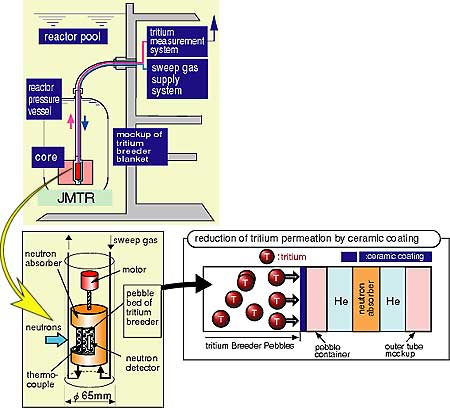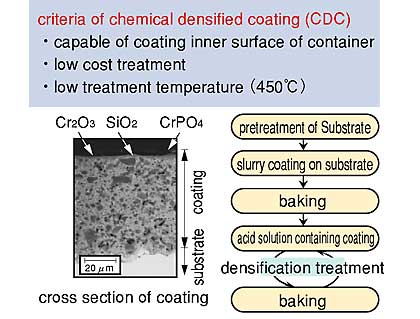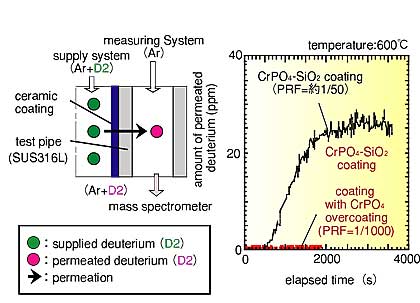For evaluation of the tritium recovery behavior in a fusion blanket, a blanket irradiation test will be carried out in the Japan Materials Testing Reactor (JMTR) (Fig. 11-1).
As tritium has high permeability, it slowly escapes through the walls of the pebble container of the tritium breeder. This permeation interferes with the accurate measurement of produced tritium.
To alleviate this difficulty, we developed the "Chemical Densified Coating (CDC)" process, which applies a ceramic coating to a metal surface to minimize tritium permeation. It is capable of forming a densified coating on either the outer or the inner surface of a tube or a container. This coating consists mainly of Cr2O3 and SiO2 (Fig. 11-2).
To evaluate the tritium permeation property of this coating, a permeation test was conducted using deuterium, which has a mass number smaller than that of tritium but has the same chemical properties as tritium. The Permeation Reduction Factor (PRF) was measured for deuterium permeated through SUS316L with and without a permeation retardant coating.
The PRF of the Cr2O3-SiO2 coating was only about 50 at 600degree Celsius. Therefore, it was understood that there were open pores in the coating. To seal the open pores, the densification treatment using Cr2O3-SiO2 with a CrPO4 overcoating was examined. The PRF of the Cr2O3-SiO2 with the CrPO4 overcoating was about 1000 at 600degree Celsius (Fig. 11-3). Further, the CrPO4 overcoating has good adhesion and resists thermal shock.
Using this combined coating, we expect the amount of permeated tritium, which has a mass number larger than that of deuterium, will be similar or less than that of permeated deuterium. The use of this coating should reduce tritium permeation and thereby improve the accuracy of the tritium measurement on the blanket irradiation test in the JMTR.
This combined coating technique will also contribute both to the effective recovery of tritium from a fusion blanket and to the optimum design of a tritium processing facility. Applying this technology to a petroleum refinery should increase production; further, an extension of plant lifetime would be expected due to reduced hydrogen embrittlement in vessels and piping. |



